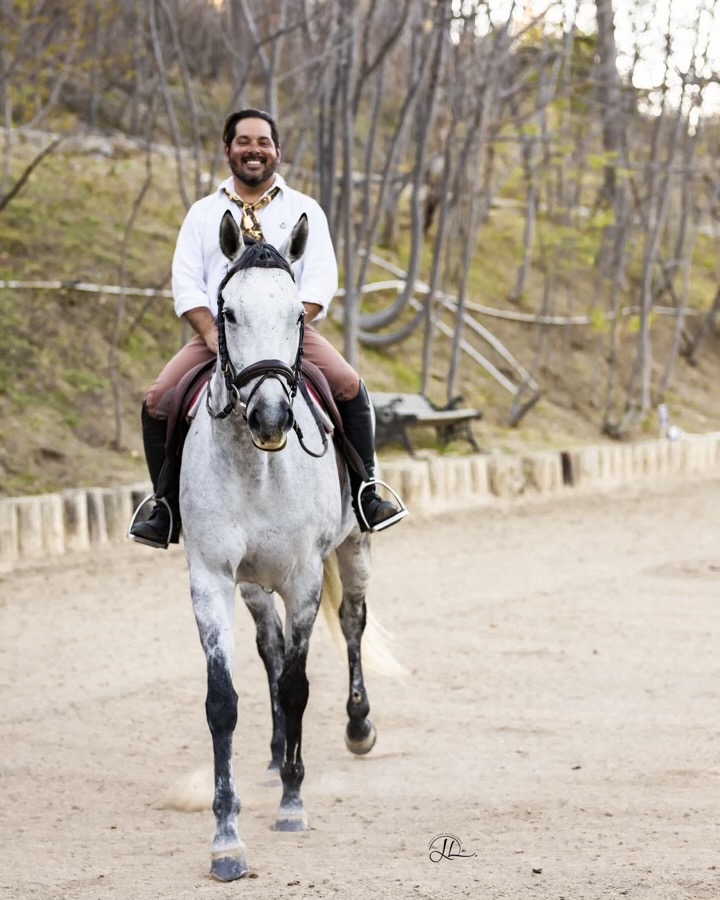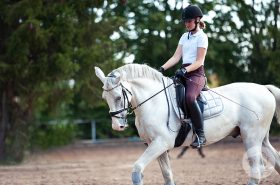How do you slow your horse down while you are riding? What do you do first when you notice your trot is too quick, you’re out of rhythm, and your instructor shouts, “slow your trot down!” Do you go straight to pulling on the reins? What else can you do to help slow down, avoid the pulling match, and will a soft rhythm ever become consistent?
Rhythm & Relaxation
Maintaining a rhythm within all gaits is the foundation of your horse’s training. Rhythm and relaxation are at the bottom of the classical dressage training scale. A rider must ride with an independent seat and leg to influence and effectively train according to classical training principles.
The horse paired with a rider who constantly cannot ride with an independent seat and leg aids can sometimes begin to have training or soundness issues. The rider who first reacts to slowing by taking hold of the reins can teach the horse to invert its back, improperly build correct muscles, or possibly create unsoundness issues with the horse. Riders should be mindful, remain patient when training, and remember to hold space for their horse to go through their learning process.
Learning Process
Pretend you are rising the trot on a lunge line, and your horse quickens their gait. Your horse will respond and slow down when you slow your seat, increasing the trot slower and slightly holding during the sit phase longer. Consistently slowing your seat first and not reverting to your habit of heaving on the reins too slowly is essential. It would be best if you allowed time, so your horse can make the connection and begin long-term training modification. It might take your horse multiple tries during the same ride before it understands what you are asking and begins to listen to your seat consistently.
Maintaining a flat back so your seat bones effectively influence during your sit phase is essential. When you slow the trot and hold with your seat slightly longer, it is similar to holding with the seat each canter stride. I often imagine a tucked pelvis in each sit phase, like the letter J. Long term, your horse will become sensitive to your aids and maintain consistency in their rhythm and within all gaits.
Secondly, the rider should begin incorporating riding half halts by taking and holding with their outside straightening rein and holding seconds longer with their seat during each sit phase in the rising trot. When a rider can coordinate all of their aids at the correct timing, their horse will begin to understand what is asked, and eventually, the ride will start to feel soft as butter.
Progression
Don’t forget, after riding your half halts; riders must apply their inside driving leg during each sit phase. The riders inside the driving leg should always follow because their horse must understand forward motion is required to use their body correctly and push forward into the rider’s contact.
An example of progression includes your horse beginning a warm-up session on a long rein, stretching long and low, and maintaining a steady rhythm with floppy reins. Additionally, a rider completing exercises at the walk, trot, canter, and jumping (yes, jumping too!) on a long rein, and their horse keeps steady, indicates the rider’s seat and leg are independent for influence to control their horse’s rhythm.
Training
Are you a rider with an independent seat? What exercises do you incorporate into your training? Can you challenge yourself more do you think?
All aids should be applied in rhythm when teaching your horse half halts using your outside rein and holding with the seat. The rider must softy give with their elbow (rider’s open phase). The release of pressure, or give is the reward for your horse. This ‘soft elbow’ must be maintained always in rhythm during each open phase.
Riding your half halts should occur often and not only when your horse overtly speeds up. I often say, “ride every stride,” because your horse can never become too balanced. Training your horse correctly takes time. Incorporating multiple training exercises with variation will help achieve the desired behavior from your horse.

Love this blog post? We think you will like Acceptance From Horses by Chris Cervantes.
*Learn more about seat bones from the horses’ side of the saddle.



